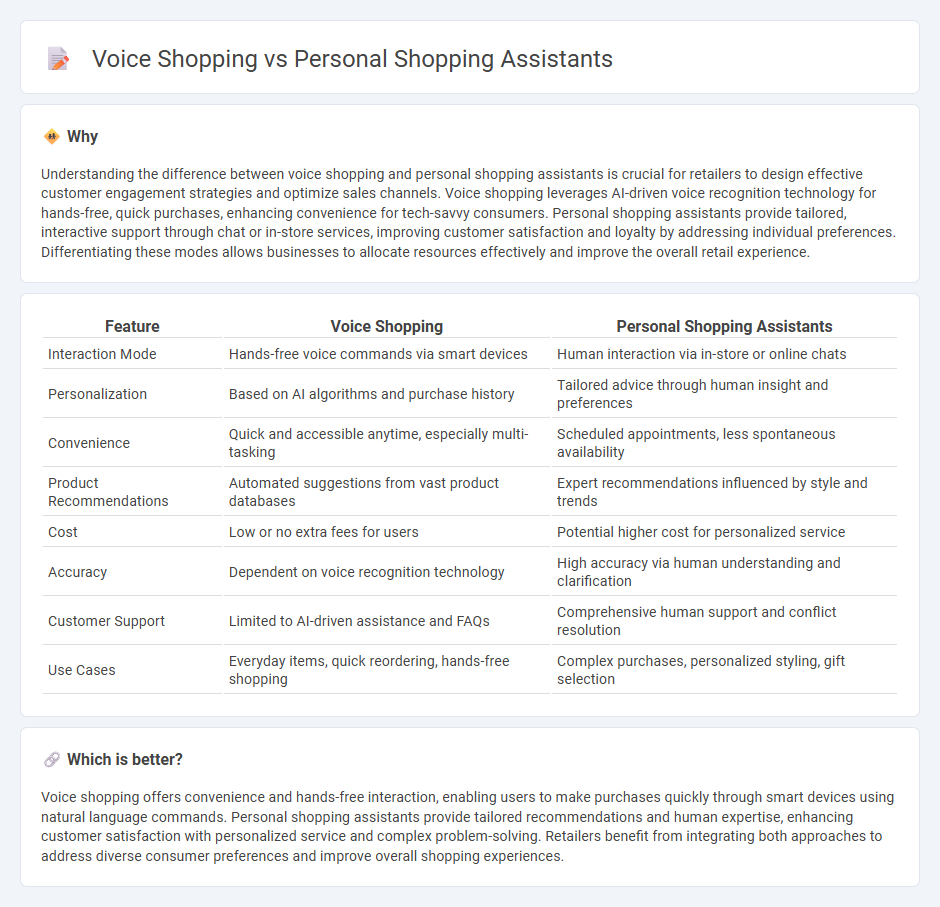
Voice shopping leverages smart devices and AI to enable hands-free purchasing through voice commands, streamlining the retail experience. Personal shopping assistants offer tailored guidance and recommendations by analyzing shopper preferences and behavior to provide a customized service. Discover how these innovations transform consumer interactions and boost retail efficiency.
Why it is important
Understanding the difference between voice shopping and personal shopping assistants is crucial for retailers to design effective customer engagement strategies and optimize sales channels. Voice shopping leverages AI-driven voice recognition technology for hands-free, quick purchases, enhancing convenience for tech-savvy consumers. Personal shopping assistants provide tailored, interactive support through chat or in-store services, improving customer satisfaction and loyalty by addressing individual preferences. Differentiating these modes allows businesses to allocate resources effectively and improve the overall retail experience.
Comparison Table
| Feature | Voice Shopping | Personal Shopping Assistants |
|---|---|---|
| Interaction Mode | Hands-free voice commands via smart devices | Human interaction via in-store or online chats |
| Personalization | Based on AI algorithms and purchase history | Tailored advice through human insight and preferences |
| Convenience | Quick and accessible anytime, especially multi-tasking | Scheduled appointments, less spontaneous availability |
| Product Recommendations | Automated suggestions from vast product databases | Expert recommendations influenced by style and trends |
| Cost | Low or no extra fees for users | Potential higher cost for personalized service |
| Accuracy | Dependent on voice recognition technology | High accuracy via human understanding and clarification |
| Customer Support | Limited to AI-driven assistance and FAQs | Comprehensive human support and conflict resolution |
| Use Cases | Everyday items, quick reordering, hands-free shopping | Complex purchases, personalized styling, gift selection |
Which is better?
Voice shopping offers convenience and hands-free interaction, enabling users to make purchases quickly through smart devices using natural language commands. Personal shopping assistants provide tailored recommendations and human expertise, enhancing customer satisfaction with personalized service and complex problem-solving. Retailers benefit from integrating both approaches to address diverse consumer preferences and improve overall shopping experiences.
Connection
Voice shopping relies on AI-powered personal shopping assistants to enhance customer convenience by enabling hands-free, natural language purchases. These assistants utilize machine learning to analyze user preferences, streamline product searches, and provide personalized recommendations within retail platforms. Integration of voice technology with personal shopping assistants significantly boosts customer engagement and increases conversion rates in the retail industry.
Key Terms
Personalization
Personal shopping assistants offer tailored recommendations based on detailed user profiles, purchase history, and real-time preferences, enhancing the overall shopping experience with precise personalization. Voice shopping relies on natural language processing to interpret commands but often lacks the nuanced understanding that enables deep customization seen in personal assistants. Discover how personalized technology is transforming retail by exploring the strengths and limitations of both approaches.
Conversational AI
Personal shopping assistants leverage advanced Conversational AI to provide personalized recommendations and streamline the online shopping experience through natural language interactions. Voice shopping utilizes speech recognition technology, enabling users to search and purchase products hands-free via smart speakers and mobile devices. Explore how these innovations are revolutionizing e-commerce and enhancing customer engagement.
Customer Experience
Personal shopping assistants offer tailored recommendations and personalized support that enhance customer satisfaction through human interaction and nuanced understanding of preferences. Voice shopping enables quick, hands-free transactions, improving convenience while sometimes lacking in-depth customization and emotional engagement. Explore how combining these tools can revolutionize customer experience in retail.
Source and External Links
5 Benefits of Providing Personal Shopping Assistant Online - Giosg - Personal shopping assistants online help clients remotely by providing shopping advice, selecting goods according to clients' style and budget, and managing orders including deliveries and returns through live chat, calls, and live videos, enhancing the overall shopping experience.
AI-Powered Personal Shopping Assistants Guide - Master of Code - AI personal shopping assistants use customer data and machine learning to offer personalized product recommendations, visual search, real-time inventory updates, and push notifications, making online shopping more customized and convenient.
AI Shopping Assistants: A Guide | Salesforce US - AI-powered shopping assistants act as virtual concierges that use natural language to help shoppers browse, compare, and purchase products by providing detailed, data-driven recommendations, improving the ecommerce experience beyond traditional search and filtering.
 dowidth.com
dowidth.com